January 7, 2021
This Week in Herreshoff History: January 7
A report from the Bristol Steam Fishing Company, an icy trip to England, keel timbers arrive by tug, an employee departs, and a nephew returns
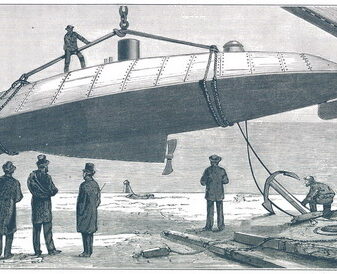
January 6 & 13, 1872
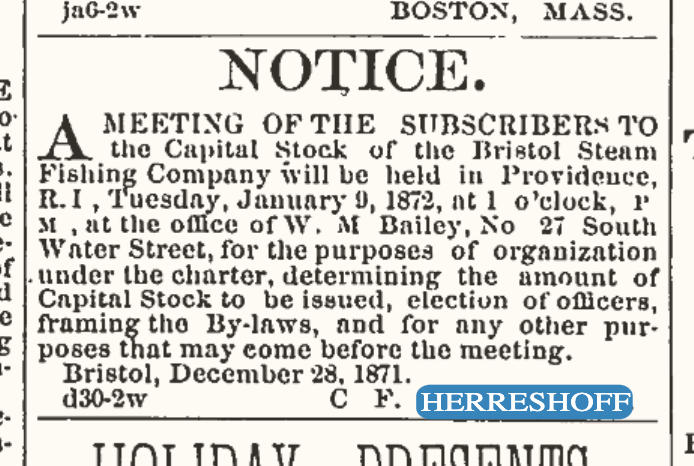
Two notices within a week appear in the Bristol Phoenix pertaining to the business interests of the Bristol Steam Fishing Company and involving several Herreshoff family members. The first announces a "meeting of the subscribers to the Capital Stock of the Bristol Steam Fishing Company" on Tuesday, January 9. The second, lengthier piece provides a summary of the meeting itself and of the company's finances for the previous year. C.F. Herreshoff and Lewis Herreshoff, J.B.H. and N.G.H.'s brothers, were both stockholders in the company. OSPRAY [sic] (HMCo. #6) was the first of three steamers J.B.H. would build for the Bristol Steam Fishing Company, and these vessels would go after menhaden from Rhode Island to Maine. OSPRAY was 72'6" overall, and followed on the heels of SEVEN BROTHERS (HMCo. #3)'s success as an able and productive pogie boat. The Phoenix reports in the January 13th article that J.B.H.'s next build for the company would be called CORMORANT, but it is likely this ended up being the steamer KINGFISHER (HMCo. #9), built on the same molds as OSPRAY and launched in April 1872. The last of J.B.H.'s vessels built for the Bristol Steam Fishing Company was WILLIAM SPICER (HMCo. #13), launched in 1874.
January 4, 1879
The Bristol Phoenix reports that N.G.H. and J.B.H. have arrived in England. The two brothers are abroad on a mission that was part delivery, part traveling salesman pitch in the U.K. They were joined by Nelson Newman and Charles Mowry, also of Bristol. What the Phoenix does not mention is that they were also in the company of a steam launch (GYMNOTUS, HMCo. #47) the bizarre looking steam torpedo boat, HMCo. #44!
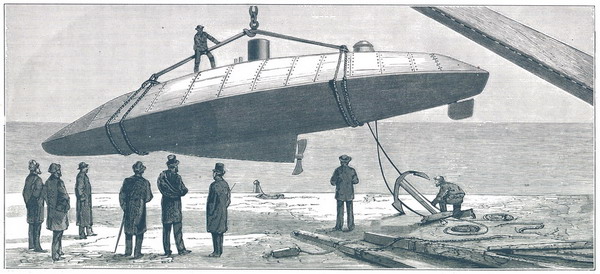
The Irish Times described the strange craft as follows in a January 10, 1879 article, courtesy of the HCR: "Passengers on the Thames may have noticed during the last few days a strange looking little craft lying off Erith Pier; a craft hardly larger in its dimensions than a lifeboat, covered in so as almost to suggest comparison with a coffin, and in form something like a squab-shaped cigar. Passengers may have noticed such a craft; but it is probable that they have passed her without observation, for, besides being small, her grey colour renders her almost undistinguishable, unless her funnel, the only conspicuous feature about her, should serve to attract attention. Yet, this little vessel has the ambition to destroy the largest and most powerful men-of-war. She is a torpedo boat of American manufacture, and is about to pass into the hands of the British Government. Built by the Herreshoff Manufacturing Company of Bristol, Rhode Island, and 57 Gracechurch Street, and bought by Mr Dunell, of Erith, under order from the Admiralty, the boat was brought over on board the National Line steamboat Denmark, and it arrived in the Thames on the 1st instant [January 1, 1879]. On Wednesday morning her machinery was inspected by the Admiralty officials, and after this inspection her capabilities were exhibited, unofficially, in a trip on the river. She was not run to show her speed, which will be tested in due course, and which is guaranteed to be sixteen knots an hour; but she was taken out to show certain special qualities in regard to going astern, making almost a dead stop, and turning within a small circle. Among those on board were Captain De Cavalier de Cuverville and Lieutenant Borel de Bretizel, naval attaches to the French Embassy; Mr Herreshoff, and Mr Dunell. Starting from Erith pier, the boat went down the Lower Rands into Long Reach, and on the measured two-mile course, turning off Purfleet, and at various times stopping, going astern, or revolving in a circle, the diameter of which was less than three times her own length. Her stopping was remarkably good, being effected from a speed of twelve miles an hour within 60 feet. After a dead stop she went astern at about the same speed as that at which she had gone ahead, and she answered to her helm with great readiness in either direction. Her turning fully justified the promise of her makers, the wake plainly showing the circle within which she moved. The evolutions of the boat must have appeared very eccentric to persons on board the passing steam vessels; the little oddity would have been seen wheeling round, as though suddenly struck with vertigo; or advancing with full speed, apparently reckless of collision; then stopping in a manner little short of miraculous; and, finally, darting away like a racer. To those, however, who understood the method of all this seeming madness, the illustration of her special powers was sufficiently satisfactory... The guaranteed speed is 16 knots. The boat is covered over with steel plates for the protection of the men and machinery from rifle shots. It only remains to say, that this minute, but possibly important, addition to the strength of the British navy proved herself, in rough water, and with a still easterly breeze, to be a good sea boat, as she is also reported to have done on her trip from her builder's yard to New York, a distance of 180 miles, performed with a consumption of one ton of coal."
January 1 & 8, 1901
The Phoenix reports that Mr. Vanderbilt's RAINBOW (HMCo. #532) has been towed back to Newport. One week later the Phoenix reports that HMCo. has shipped a high-speed engine to New York, and the timber has arrived for the keel of a new "40 footer." This was the yacht HUMMA (HMCo. #553), who was in actuality 44' on the waterline and 71' overall.
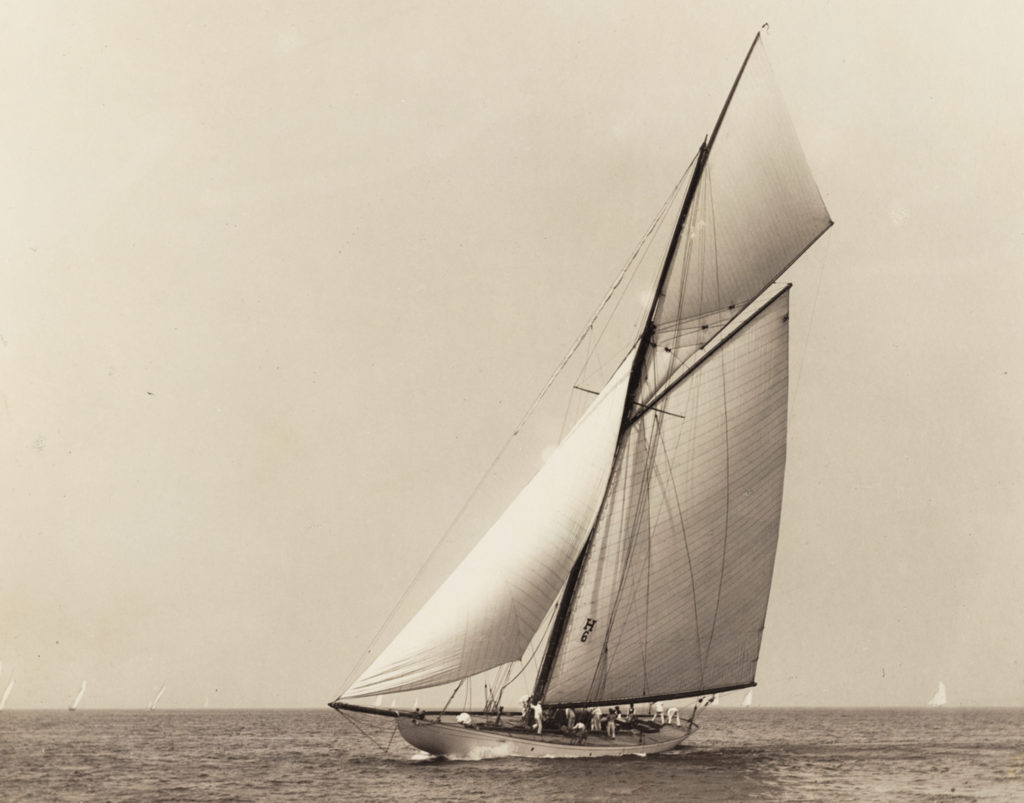
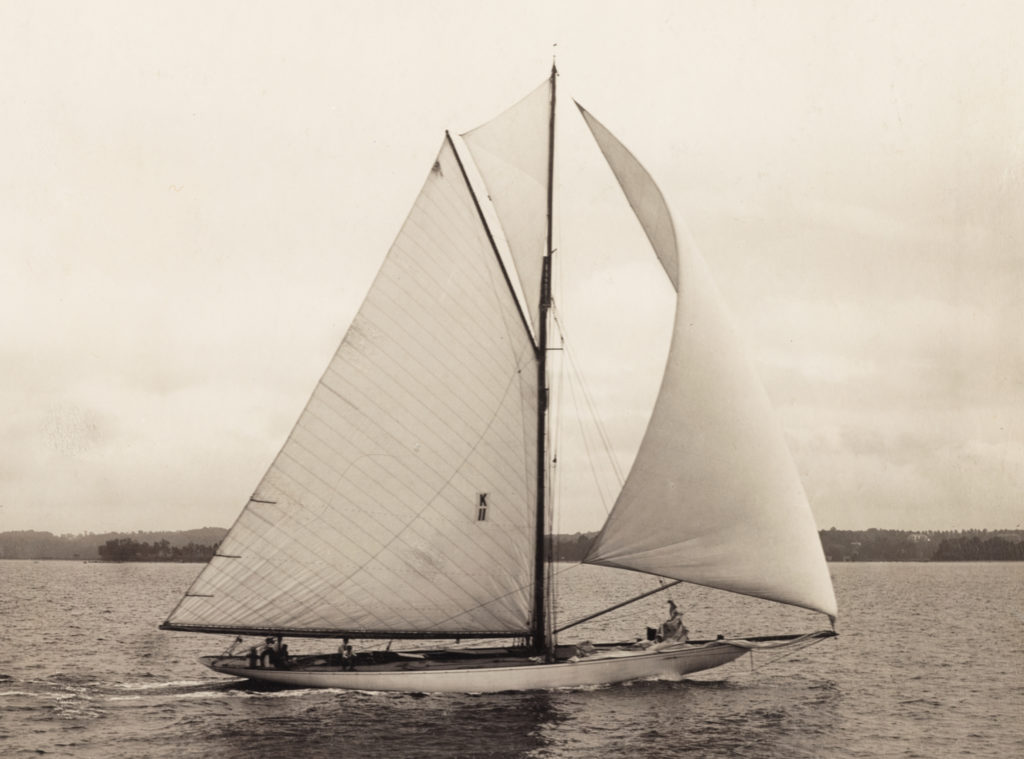
January 7 & 11, 1910
The Bristol Phoenix reports one impending arrival and one impending departure: J.B.H. and N.G.H had offered their nephew Charles Frederick Herreshoff, son of their brother James, a position with the company. Charles accepted, and would return to the east coast after a period of residence in California. A few days later, the Phoenix publishes notice that sailmaker Orrin K. Thurston will be leaving HMCo. to become a partner in a sailmaking firm in Providence, soon to be known as Thurston, Hyllested & Co.
